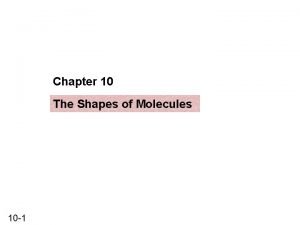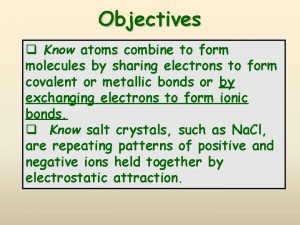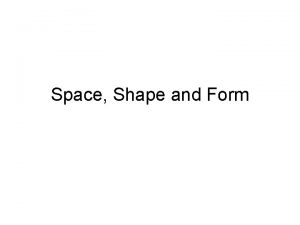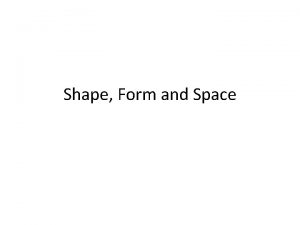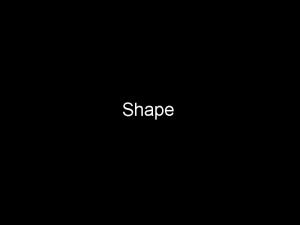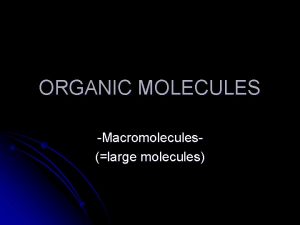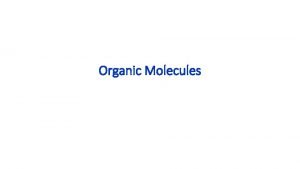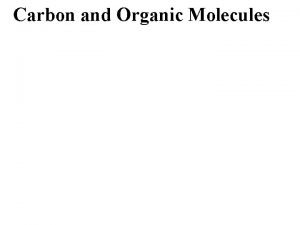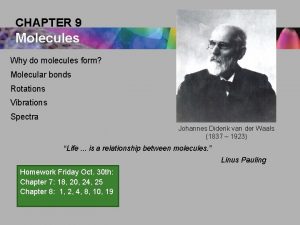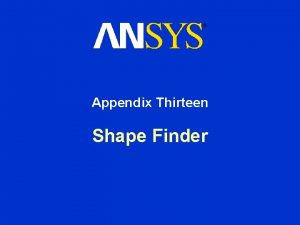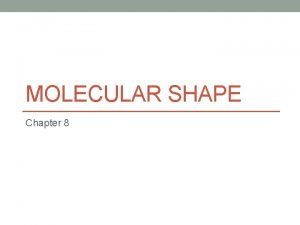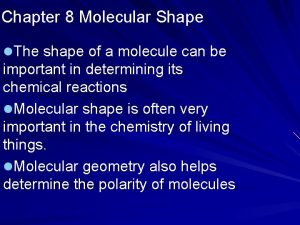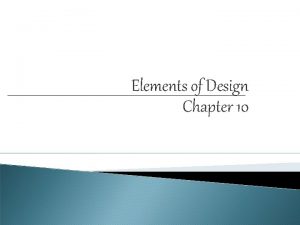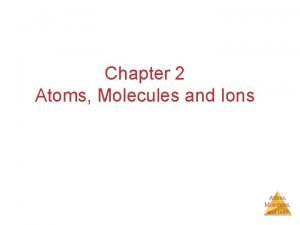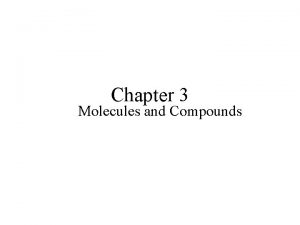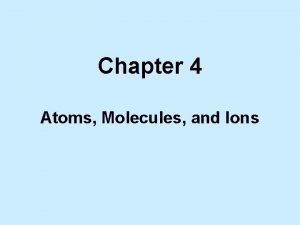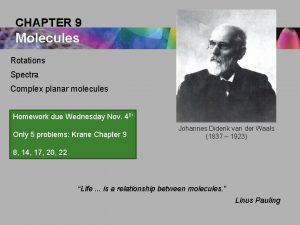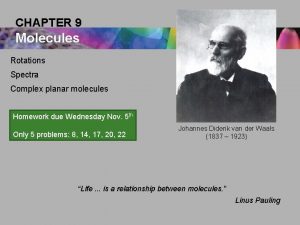Chapter 6 The Shape of Molecules Why Care
























- Slides: 24

Chapter 6 –The Shape of Molecules

Why Care about Shapes of Molecules • Dot diagrams show atoms are connected in a molecule and how valence electrons are arranged – Problem: not 3 D

Why Care About the Shape of Molecules § Shape determines molecular properties – Melting point – Boiling point – Chemical reactivity

VSEPR Model (Valence Shell Electron Pair Repulsion) Theory that determines how molecules arrive at a three dimensional shape § Repulsion between the sets of valence-level electrons surrounding an atom causes these sets to be oriented as far apart as possible § All electrons are negatively charged. § Like charges repel. §

Are These Bonds As Far Apart As Possible? H No Way! H C H H B H

Predicting a VSEPR Structure § Draw Lewis structure. § Determine the number of electron groups around the central atom § 1 electron group is equal to § Single, Double, Triple Bond or Lone Pair § Count up lone pairs on the central atom § Determine the shape of the molecule § Determine the bond angle

Base VSEPR Structure • 2 Electron Groups • Linear • Bond angles of 180˚ X A X

Base VSEPR Structure • 3 Electron Groups • Trigonal Planar • Bond angles of 120˚ X A X X

Base VSEPR Structure • 4 Electron Groups • Tetrahedral Geometry • Bond angles of 109. 5˚ X X A X X

Your Turn • Determine shape and bond angles for – BI 3 Trigonal Planar, 120° – Si. Br 4 Tetrahedral, 109. 5° – Be. F 2 Linear, 180°

Lone Pairs of Electrons • Lone Pairs of Electrons make the bond angle a little bit smaller • More repulsion

1 Lone Pairs on Trigonal Planar • Bent – Bond Angles of < 120 A X X

1 Lone Pair w/ Tetrahedral • Trigonal Pyramidal – Bond Angles 107 X A X X

2 Lone Pairs w/ Tetrahedral • Bent – Bond Angles = 104. 5 A X X

Your Turn • Determine shape and bond angles for – PBr 3 Trigonal Pyrimidal, 107° – O 3 Bent, <120° – Se. O 2 Bent, <120°

Electronegativity • The ability of an atom in a molecule to attract shared electrons to itself. • • – Developed by Linus Pauling Values range 0. 7 to 4. 0 Fluorine = 4. 0 Francium and Cesium = 0. 7 What is the periodic trend? – Top to Bottom – Decrease – Left to Right Increase

Molecular Polarity • A polar molecule is one that has a partially positive and partially negative side • Molecules are Always nonpolar if they are one of the 3 base shapes w/ the same atom at the ends • Molecules are Always polar if their bond dipoles do not cancel out • Molecules are polar if they do not have the same atoms at the end, or bent, or pyramidal

Intermolecular Forces • Forces of attraction between molecules • Intermolecular Forces are responsible for melting and boiling points • Strong IMF raise BP and MP • Three different types of IMF • London Forces, Dipole-Dipole, and Hydrogen Bonding

Dipole - Dipole • Permanent attraction between polar molecules

Hydrogen Bonding • Extra Strong attraction between polar molecules where H is bonded to F, N, O


London Forces • Temporary Dipole caused by the collision of nonpolar molecules


So What? • Arrange the following in order of increasing boiling points – H 2, NH 3, PH 3, H 2 O – – H 2 = -235 ºC PH 3 = -88 ºC NH 3 = -33 ºC H 2 O = 100 ºC
 Organic molecules vs inorganic molecules
Organic molecules vs inorganic molecules Hey bye bye
Hey bye bye Pf3 bond angle
Pf3 bond angle Primary secondary tertiary medical care
Primary secondary tertiary medical care Atoms combine to form
Atoms combine to form Dont ask
Dont ask Aerofoil shapes
Aerofoil shapes Shape matching and object recognition using shape contexts
Shape matching and object recognition using shape contexts Template matching
Template matching Chapter 3 molecules of life
Chapter 3 molecules of life Chapter 2 atoms molecules and ions
Chapter 2 atoms molecules and ions Hình ảnh bộ gõ cơ thể búng tay
Hình ảnh bộ gõ cơ thể búng tay Slidetodoc
Slidetodoc Bổ thể
Bổ thể Tỉ lệ cơ thể trẻ em
Tỉ lệ cơ thể trẻ em Voi kéo gỗ như thế nào
Voi kéo gỗ như thế nào Tư thế worms-breton
Tư thế worms-breton Hát lên người ơi
Hát lên người ơi Các môn thể thao bắt đầu bằng tiếng nhảy
Các môn thể thao bắt đầu bằng tiếng nhảy Thế nào là hệ số cao nhất
Thế nào là hệ số cao nhất Các châu lục và đại dương trên thế giới
Các châu lục và đại dương trên thế giới Công thức tiính động năng
Công thức tiính động năng Trời xanh đây là của chúng ta thể thơ
Trời xanh đây là của chúng ta thể thơ Cách giải mật thư tọa độ
Cách giải mật thư tọa độ 101012 bằng
101012 bằng


